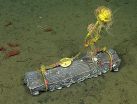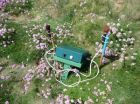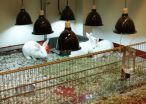(Press-News.org) By changing row-crop management practices in economically and environmentally stable ways, US farms could contribute to improved water quality, biological diversity, pest suppression, and soil fertility while helping to stabilize the climate, according to an article in the May issue of BioScience. The article, based on research conducted over 25 years at the Kellogg Biological Station in southwest Michigan, further reports that Midwest farmers, especially those with large farms, appear willing to change their farming practices to provide these ecosystem services in exchange for payments. And a previously published survey showed that citizens are willing to make such payments for environmental services such as cleaner lakes.
The article is by G. Philip Robertson and six coauthors associated with the Kellogg Biological Station, which is part of the Long Term Ecological Research Network. The research analyzed by Robertson and colleagues investigated the yields and the environmental benefits achievable by growing corn, soybean, and winter wheat under regimes that use one third of the usual amount of fertilizer—or none at all—with "cover crops" fertilizing the fields in winter. The research also examined "no-till" techniques. The regime that used fewer chemicals resulted in more than 50 percent reductions in the amount of nitrogen that escaped into groundwater and rivers, with crop yields close to those of standard management. Nitrogen pollution is a major problem in inland waterways and coastal regions, where it contributes to the formation of "dead zones."
The no-till and reduced chemical regimes also mitigated greenhouse warming by taking up greenhouse gases from the atmosphere, in contrast to standard management, which produces significant greenhouse warming by emitting nitrous oxide. The zero-chemical regime mitigated greenhouse warming enough to compensate for the emissions produced under standard management. All three regimes also led to more fertile soil compared with conventional management.
The environmentally improved farming practices that Robertson and his colleagues studied are more complex than conventional ones. But the authors found that although sustained profitability is generally farmers' overriding concern, substantial proportions would accept payments to adopt such practices, especially those with large farms. And a 2009 survey in Michigan found that members of the public indicated they were willing to pay higher taxes so that land managers could participate in stewardship programs to benefit lakes; a smaller number were willing to pay for a reduction in greenhouse gas emissions.
Robertson and his colleagues argue that in coming decades, human population and income growth will drive agriculture to ever-higher intensities. The danger is that it will become more vulnerable to climate extremes and pest outbreaks. "Now is the time to guide this intensification in a way that enhances the delivery of ecosystems services that are not currently marketed," they conclude.
INFORMATION:
BioScience, published monthly by Oxford Journals, is the journal of the American Institute of Biological Sciences (AIBS). BioScience is a forum for integrating the life sciences that publishes commentary and peer-reviewed articles. The journal has been published since 1964. AIBS is a meta-level organization for professional scientific societies and organizations that are involved with biology. It represents nearly 160 member societies and organizations. Follow BioScience on Twitter @BioScienceAIBS.
Oxford Journals is a division of Oxford University Press. Oxford Journals publishes well over 300 academic and research journals covering a broad range of subject areas, two-thirds of which are published in collaboration with learned societies and other international organizations. The division been publishing journals for more than a century, and as part of the world's oldest and largest university press, has more than 500 years of publishing expertise behind it. Follow Oxford Journals on Twitter @OxfordJournals
Farming for improved ecosystem services seen as economically feasible
Benefits to water and soil quality plus climate stabilization achieved with good crop yields
2014-04-09
ELSE PRESS RELEASES FROM THIS DATE:
DNA data could help doctors treat MRSA shows new study
2014-04-09
A team of scientists led by the University of Bath has developed a new technique to predict the toxicity of an MRSA infection from its DNA sequence. With the MRSA superbug an increasing problem in hospitals and communities, this new technique could soon help clinicians better decide the best course of treatment for infections.
Bacterial pathogens, such as MRSA, cause disease in part due to their toxicity, or the bacterium's ability to damage a host's tissue. In a study published online today in Genome Research, researchers used the genome sequence of MRSA to predict toxicity ...
Stressful environments genetically affect African-American boys
2014-04-09
PRINCETON, N.J.—Stressful upbringings can leave imprints on the genes of children as young as age 9, according to a study led by Princeton University and Pennsylvania State University researchers. Such chronic stress during youth leads to physiological weathering similar to aging.
A study of 40 9-year-old black boys, published in the Proceedings of the National Academy of Sciences, shows that those who grow up in disadvantaged environments have shorter telomeres — DNA sequences that generally shrink with age — than their advantaged peers. The researchers also report ...
Bone marrow stem cells show promise in stroke treatment, UCI team finds
2014-04-09
Irvine, Calif., April 9, 2014 — Stem cells culled from bone marrow may prove beneficial in stroke recovery, scientists at UC Irvine's Sue & Bill Gross Stem Cell Research Center have learned.
In an analysis of published research, neurologist Dr. Steven Cramer and biomedical engineer Weian Zhao identified 46 studies that examined the use of mesenchymal stromal cells – a type of multipotent adult stem cells mostly processed from bone marrow – in animal models of stroke. They found MSCs to be significantly better than control therapy in 44 of the studies.
Importantly, the ...
See what a child will look like using automated age-progression software
2014-04-09
It's a guessing game parents like to ponder: What will my child look like when she grows up? A computer could now answer the question in less than a minute.
University of Washington researchers have developed software that automatically generates images of a young child's face as it ages through a lifetime. The technique is the first fully automated approach for aging babies to adults that works with variable lighting, expressions and poses.
"Aging photos of very young children from a single photo is considered the most difficult of all scenarios, so we wanted to focus ...
Sunken logs create new worlds for seafloor animals
2014-04-09
MOSS LANDING, CA — When it comes to food, most of the deep sea is a desert. Many seafloor animals feed on marine snow—the organic remnants of algae and animals that live in the sunlit surface waters, far above. However, marine snow only falls as a light dusting and doesn't have much nutritional value. Thus, any other sources of food that reach the deep sea provide a temporary feast. Even bits of dead wood, waterlogged enough to sink, can support thriving communities of specialized animals. A new paper by biologists at the National Evolutionary Synthesis Center and the Monterey ...
Scientists reconstruct ancient impact that dwarfs dinosaur-extinction blast
2014-04-09
WASHINGTON, D.C. -- Picture this: A massive asteroid almost as wide as Rhode Island and about three to five times larger than the rock thought to have wiped out the dinosaurs slams into Earth. The collision punches a crater into the planet's crust that's nearly 500 kilometers (about 300 miles) across: greater than the distance from Washington, D.C. to New York City, and up to two and a half times larger in diameter than the hole formed by the dinosaur-killing asteroid. Seismic waves bigger than any recorded earthquakes shake the planet for about half an hour at any one ...
Counting the invisible by sound -- a new approach to estimate seabird populations
2014-04-09
AUDIO:
This is a typical one minute recording of an active Cory's Shearwater colony on the island of Corvo in the North Atlantic Ocean, June 2011.
Click here for more information.
Seabirds nest in places that are inaccessible for most humans - vertical cliffs and remote islands surrounded by raging waves. Worse still, many seabirds lay their eggs in burrows or cavities where they are protected from inclement weather and invisible for researchers. Hidden under rocks or in burrows ...
Rabbits kept indoors could be vitamin D deficient
2014-04-09
CHAMPAIGN, Ill. — Rabbits that remain indoors may suffer from a lack of vitamin D, researchers report in a new study. In rabbits kept as pets or used in laboratory studies, the deficiency could lead to dental problems, undermine their cardiovascular health, weaken their immune systems and skew scientific findings.
The study found that regular exposure to artificial ultraviolet B light for two weeks doubled rabbits' serum vitamin D levels – an increase not seen in animals raised in artificial light lacking UVB radiation. Future studies will seek to determine optimal levels ...
Recycling astronaut urine for energy and drinking water
2014-04-09
On the less glamorous side of space exploration, there's the more practical problem of waste — in particular, what to do with astronaut pee. But rather than ejecting it into space, scientists are developing a new technique that can turn this waste burden into a boon by converting it into fuel and much-needed drinking water. Their report, which could also inspire new ways to treat municipal wastewater, appears in the journal ACS Sustainable Chemistry & Engineering.
Eduardo Nicolau, Carlos R. Cabrera and colleagues point out that human waste on long-term journeys into ...
Can animals really help people in hospitals, aged care?
2014-04-09
While many people have an opinion on whether animals can help to improve wellbeing and care for patients in hospitals, does anyone really know whether there are benefits both for the patients and the animals themselves?
Not according to a team of researchers from the University of Adelaide, which has conducted a worldwide review of all studies looking at the impact of "animal interventions" in healthcare settings for children.
The researchers, from the University's School of Psychology and School of Animal and Veterinary Sciences, have found that despite theories emerging ...
LAST 30 PRESS RELEASES:
Air pollution exposure and birth weight
Obstructive sleep apnea risk and mental health conditions among older adults
How talking slows eye movements behind the wheel
The Ceramic Society of Japan’s Oxoate Ceramics Research Association launches new international book project
Heart-brain connection: international study reveals the role of the vagus nerve in keeping the heart young
Researchers identify Rb1 as a predictive biomarker for a new therapeutic strategy in some breast cancers
Survey reveals ethical gaps slowing AI adoption in pediatric surgery
Stimulant ADHD medications work differently than thought
AI overestimates how smart people are, according to HSE economists
HSE researchers create genome-wide map of quadruplexes
Scientists boost cell "powerhouses" to burn more calories
Automatic label checking: The missing step in making reliable medical AI
Low daily alcohol intake linked to 50% heightened mouth cancer risk in India
American Meteorological Society announces Rick Spinrad as 2026 President-Elect
Biomass-based carbon capture spotlighted in newly released global climate webinar recording
Illuminating invisible nano pollutants: advanced bioimaging tracks the full journey of emerging nanoscale contaminants in living systems
How does age affect recovery from spinal cord injury?
Novel AI tool offers prognosis for patients with head and neck cancer
Fathers’ microplastic exposure tied to their children’s metabolic problems
Research validates laboratory model for studying high-grade serous ovarian cancer
SIR 2026 delivers transformative breakthroughs in minimally invasive medicine to improve patient care
Stem Cell Reports most downloaded papers of 2025 highlight the breadth and impact of stem cell research
Oxford-led study estimates NHS spends around 3% of its primary and secondary care budget on the health impacts of heat and cold in England
A researcher’s long quest leads to a smart composite breakthrough
Urban wild bees act as “microbial sensors” of city health.
New study finds where you live affects recovery after a hip fracture
Forecasting the impact of fully automated vehicle adoption on US road traffic injuries
Alcohol-related hospitalizations from 2016 to 2022
Semaglutide and hospitalizations in patients with obesity and established cardiovascular disease
Researchers ‘listen in’ to embryo-mother interactions during implantation using a culture system replicating the womb lining
[Press-News.org] Farming for improved ecosystem services seen as economically feasibleBenefits to water and soil quality plus climate stabilization achieved with good crop yields







